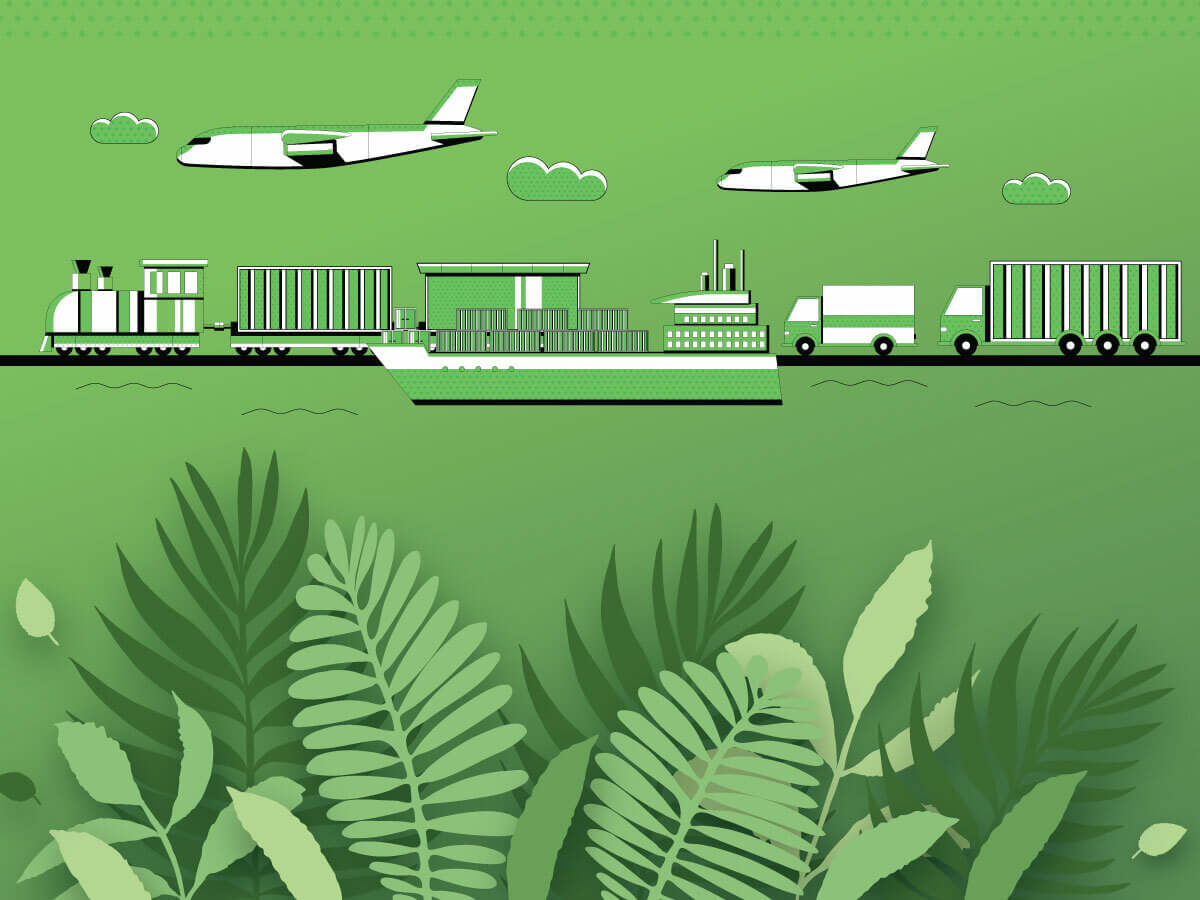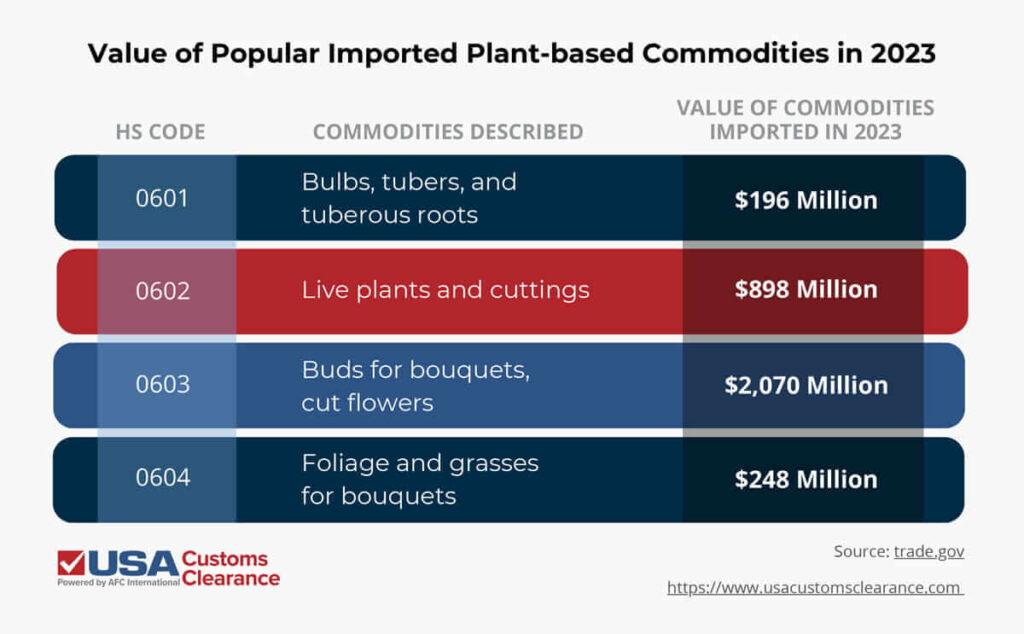
If you’re considering importing plants to the USA, then you’ve probably noticed that it’s not a simple process. There are many rules and regulations, and for inexperienced importers, they can be difficult to deal with.
Key Takeaways
Join us as we get down to the root of requirements for importing plants into the United States.
In 2023, the U.S. imported billions of dollars worth of plants and plant-based products. Decorative and ornamental plants such as bushes, trees, and flowers were among the most popular goods in this category. To give you a general idea of the industry, I’ve compiled information from trade.gov about the value of some of the most in-demand plant imports.

The top five countries that supplied these products to the U.S. in 2023 were:
Given the diversity of applications plants can be used for, it’s easy to see why consumer demand is so high. However, in order to make sure those consumers and the environment don’t suffer any ill effects, plants are among the most strictly regulated products that can be imported to the U.S.
Different importing requirements exist for different kinds of plants and the industries in which they’re used. However, one requirement nearly all plant imports share is the inclusion of a phytosanitary certificate with the shipment. This certificate verifies inspection by the exporting country’s official National Plant Protection Organization (NPPO).
Be aware that plants and seeds can be treated with slightly different rules.
For example, you can import small amounts of seed without an NPPO certificate under certain conditions, which include:
You will need a permit to import plants under most circumstances. There are different permits based on the type of plants you’re importing and how they’re to be used.
APHIS has an eFile system that allows importers to apply for any necessary permits online. In the list below, you’ll find the most common examples.
With that explained, let’s run through some more specific import requirements that apply to particular plants.
If you’re importing plants or plant products covered by CITES or the Endangered Species Act, USDA regulation 7 CFR 355 requires you to obtain a USDA Protected Plant Permit via PPQ form 621. CITES-listed plants are required to enter the US through a designated port.
Some examples of plants in this category include:
If you’re unsure whether your imports require a permit, you can access the checklist of CITES species.
APHIS has a searchable, free-to-use database called Agricultural Commodity Import Requirements (ACIR). It allows people to search for authorized fruits and vegetables and their U.S. import requirements. Commodities approved under the Q56 revision will not be reflected in the Code of Federal Regulations, but rather in the ACIR database.
The Lacey Act was passed to combat trafficking in illegal wildlife and plants. It is unlawful to import certain plants and plant products without an import declaration. This declaration must be made if your shipment is a formal entry that fulfills all the following criteria.
Shipments that check all of these boxes will require a Lacey Act declaration. You or your importer of record (usually a customs broker) will need to file it via the CBP Automated Commercial Environment (ACE) portal.

In some cases, plants will need to be quarantined and treated for potential infestations or diseases. APHIS will determine the type of treatment necessary for qualified specimens. These treatments can be chemical and non-chemical.
Fresh fruits and vegetables may require quarantine prior to being allowed into the country. Irradiation treatments that have been developed recently are considered viable phytosanitary options for eliminating certain pests.
The quarantine is in place to widen the range of plants and foreign sources from which plants can be imported. Through careful monitoring and treatment, plants can be confirmed to be free of pests before entering the market. The regulations are listed and specified in 7 CFR 319.37-23. Requirements for post-entry quarantine are located in the plants for planting manual.
You can’t have healthy plants without high-quality soil. Read our guide on importing soil to the U.S. for more information.
There are several fees associated with any import transaction, including shipping costs and customs duties Shipping fees will vary based on factors such as distance traveled and mode of transport. Duties are a little easier to predict up front.
Our HTS Code Look-Up tool can show you what duty rates to expect on your shipment. These rates will vary based on the type of plants you’re importing and their country of origin
The responsibility of paying duties always falls on the importer of record (IoR). However, the IoR will change depending on the Incoterms® of the shipment. To learn more, take a look at our blog entry What Are Incoterms?
The popularity of aroid plants, also known as arums, stems largely from their ability to thrive indoors and outdoors without significant amounts of direct sunlight. Plants of this genus, which vary from vines to flowers, grow on almost every continent. However, some of the most popular varieties grow best in northern Africa, the Mediterranean, and Asia, meaning they often have to be imported for sale in the U.S.
If you’re interested in importing arums to the United States, you’ll likely be dealing with suppliers in the aforementioned areas or specialized nurseries in Ecuador. Regardless of your supplier’s location, you’ll need general permit PPQ 587 to bring the plants into the country.
Since the arum genus isn’t explicitly mentioned in the HTS, aroids can be difficult to classify for importing. For instance, you might think it’s perfectly logical to classify a peace lily under the HTS code for lilies. However, this would be a mistake, since the plant in question only resembles members of the true lily family.
In this way, aroids highlight the value of consulting with a customs broker during the plant importing process to ensure accuracy and avoid delays in the customs clearance process.
Thailand is home to some of the most sought-after decorative plants among U.S. consumers. These include:
Our article dedicated to importing flowers goes into greater detail about the specifics of bringing these plants into the U.S.
A customs broker’s job is to ensure the import and export of goods goes as planned. They’ll deal with the formalities and facilitate the clearance of goods through customs processes.
Given how strictly regulated some plants are, partnering with a broker can help you avoid delays, fines, and censure from CBP.
From fruits to flowers and everything in between, importing plants is a ripe opportunity for resellers in the United States. If you want to take advantage of consumer demand for plants and plant-based products, we can help.
USA Customs Clearance has helped thousands of customers avoid the potential pitfalls of the importing process. We can ensure that your imported plants are compliant with all necessary regulations and even submit any required documents to CBP on your behalf.
Our full suite of services includes:
Ready to get started? Call the import experts at (855) 912-0406 or fill out a contact form online and leaf the hard part to us.
 Copy URL to Clipboard
Copy URL to Clipboard

Google is changing how it surfaces content. Prioritize our high-quality guides and industry-leading coverage in search results by setting usacustomsclearance.com as a preferred source.
My friend what’s to import some ayawasca roots from Brazil ?
Hi, I want to import some bare root roses from China. Can you help me?
planning to import baby snake plants by 40' container Can I have inspection/certification by USDA in the port of origin? Source: Ecuador
Hello,
I bought a nursery-grown agave from eBay (only one plant), and the seller will send the plant from South Africa with a phytosanitary certificate. Do I need to apply for any permits or other documentation?
Looking to import a Vietnamese Blue Bell Bonsai and other bonsai trees, do I need to have a specific permit fron the seller? They are private sellers.
Thank you.
Fred R
I'm living in CA. Can I buy some orchid on Ebay, but they ship from Thailand or Vietnam...to USA? Is there anything trouble.
hello! im planning to import plants (house plants for collection) to Chicago Illinois from indonesia/philippines. i read that if it is 12 or fewer plants, the phytosanitary permit is needed. do i still need a permit or any other documents in order to push through the importation?
do i have to do anything else other than informing the sender to comply the phyto certificate? thank you!
hello! im planning to import plants (house plants for collection) from indonesia/philippines. i read that if it is 12 or fewer plants, the phytosanitary permit is needed. do i still need a permit or any other documents in order to push through the importation?
do i have to do anything else other than informing the sender to comply the phyto certificate? thank you!
We wish to learn about import/export of dahlia tubers from individual growers (not commercial) to foster exchange of new varieties. Once I have the necessary authoritative information, it will be published in the American Dahlia Society Bulletin for better understanding of requirements and special conditions. Looking through the APHIS Manuals, I see little direct reference to dahlias. Pls advise.
If I’m getting 6 succulents shipped bare root from Thailand accompanied by a phytosanitary certificate, do I need to do anything else to make sure they arrive safely?
I would like to bring some agaves and cacti to plant in our yard. I live in El Paso so its a short trip to Juarez. May I bring up to 12 plants? Included would be 1 madagascar palm Pachypodium lamerei
Good morning! I have gymno cacctus house plant. I'am planning to bring them to US. Do I need permit?
Hi - I want to import some mulberry cuttings. I read that a permit is not needed when importing 12 or fewer plants. How does this apply to mulberry cuttings for propagation? I wanted to have 15 cuttings sent from a few cultivars. What rules apply? Am I exempt?
Hi Timothy,
Your situation will vary depending on whether these cuttings are for personal or commercial use. One of our customs experts will reach out to you shortly to obtain additional information so that we can assist you. We look forward to helping you!
Good day Custom Agent,
What is your total and complete cost, to complete the required documentation that is required in order to send plant-rhizomes from Canada to the U.S., on an order to order basis. I need certification to deliver rhizomes to customers in the U.S for regular, on -going, domestic, small order(s) basis.
Thank you, Eve
Hi Eve,
In order to provide you with an accurate quote, we need to obtain specific information from you including the tariff classification of your plant-rhizomes, their value, and more. One of our customs experts will reach out to you shortly to obtain the additional information that we need. We look forward to helping you!
I just have a basic question. I am importing plants from thailand. I live in Seattle. When plants come in do they go to a random port 9f entry or would they enter thru the customs nearest to me which would be Seattle. I'm just trying to understand the process. Thank you.
Hi Katherine,
There are multiple plant inspection stations located that are operated by the USDA and located throughout the U.S. There happens to be one in Seatac, Washington which is where your plants would go through if you import through Seattle.
I am planing to import mango plants from India I need to know if you can help me.
Hi Ravi,
We can definitely help you! One of our import experts will reach out to you shortly to obtain additional information so that we can assist you.